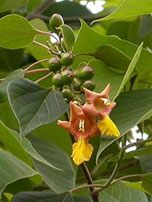SHAHEED KARTAR SINGH SARABHA AYURVEDIC MEDICAL COLLEGE & HOSPITAL
Affiliated to Guru Ravidas Ayurved University, Hoshiarpur Punjab
Affiliated to Guru Ravidas Ayurved University, Hoshiarpur Punjab

Botanical Name : Gmelina arborea Roxb.
Family : Verbenaceae
Introduction :
Kãsmarya is important among the trees used in Yajña. one of the plants in dasamoola. Its fruit is one among the ‘Madhura Triphalã (three sweet fruits).It is Brmhana, Vrsya and Rasãyana in nature. Its fruit consider as the substitute for draksha, if it is available more. Now a days draksha is more available than fruit of kasmira. The name gambari popular among in tribal people in Bihar.
Names in different Indian languages :
Hindi : Gambhari, Gambhara, gamari
Telugu : Gummadi, Peggumudu
Tamil : Kumadi, perumkumadi, Umi-thekku
English : Comb teak, cashmere tree
Marathi : Shivana
Kanada : kumbalamara
Malayalam : Umilu, kumpil, kumil
Bengali : Gamar
Punjabi : Gambhari
Gujarati : Savan
Sanskrit : Gambhari, kasmari
Synonyms :
Kaashmarya, Sarvatobhadraa, Bhadra, Mahaabhadraa, Sadaabhadraa, Madhuparnikaa, Sriparni, Pitarohini, Hiraa, Bhadraparni, Trishati.
Premna arborea Roth
Classification according to Charaka, Susrutha & Vagbhata :
Charaka
srothahara, Dãhaprasamana, Virecanopaga
Susrutha
Sãrivãdi, Brhat Pancamula
Vagbhata
Sarivadi
Morphology :
A large deciduous tree,16- 20 m high, with whitish grey corky lenticellate bark, exfoliating thin flakes .
Leaves— simple, opposite, glabrous above, large tomentose underneath. cordate-ovate, acuminate.
Flowers— yellow, tinged with brown, in terminal and axillary racemifom paniclcs, composed of lateral cymes.
Fruits— drupes, yellow when ripe.
seeds— oblong. Flowering in February-April & fruiting in April-July.
Habitat & Distribution :
Found throughout India
Chemical Constituents :
arborone, 7-oxodihydrogmelinol, paulownin acetate and epieudesmin, beta-sitosterol, ceryl alcohol, gmelinol; butyric & tartaric acids: apigenin, premnazole, arborone, arhoreol, isoarboreol, cutytyl ferulate, epieudesmin, gmelanore, gmelafuran. gummadiol, non-saponifiable fraction, saponifiable- fraction, apiosylskimmin, octacosanol etc.
Properties :
Rasa Tikta, Kasaya. Madhura
Guna Guru
Virya Usna
Vipäka Katu
Karma :
Vata-pittahara, Bhedana, Sothahara, Dipana-pãcana, Medhya
stomachic, laxative, antibilious, demulcent, galactagogue, anticephalalgic.
Indications :
Bhrama, Sotha, Trsnã, AmaüIa, Aras, Visa roga, Dãha, Jvara
Roots are acrid, bitter, laxative. Oedema, dysuria, haemorrhagic diseases Useful in fever, hallucination, haemorrhoids, burning sensation. Flowers are useful in skin disease, fruits are astringent, diuretic. It promotes the growth of hair, useful in anaemia, leucorrhoea.
Fruit—Raktapittahara mentioned by caraka
Flower— Vrsya, Balya, Raktapittahara
Part Used :
Root, fruit, flower, leaves
Dosage :
Root bark decoction 50-100 ml, fruit powder 2-4 g.
External uses :
Because of cooling and soothing actions, the leaves relieve burning and pain. In such cases, leaves are tied to the affected part. Paste of the leaves is applied over the forehead in case of headache caused by fever.
Internal uses :
Central Nervous system : It is used in vertigo, brain debility and vata disorders. It is also a brain tonic.
Digestive system : Fruit- relieves excessive thirst; roots aperients, improves appetite and digestion, so used in diarrhoea, constipation and haemorrhoids.
Circulatory system : The bark of the root is used internally in oedema due to any cause, as it relieve oedema. Its fruit is cardiotonic. Its juice is useful in caydiac disorders and the mixture of roots of gambhari + gunja leaves + yashtimadhu + sugar with milk is a good galactogoque
Respiratory system : Ripe fruit is a nutritive tonic, so useful in tuberculosis and cachexia.
Urinary system : Fruits and leaves are diuretic, The juice is given in dysuria, gonorrhoeae and cystitis. In such cases if the juice is given along with cow’s milk and sugar, it increases urination, relieves pain and swelling.
Reproductive system : Besides being a galactagogue, the fruit is aphrodisiac Fruits are used in semen debility and to prevent miscarriage. Decoction of the root bark is given in postpartum disorders. It relieves uteritis, fever and other symptoms and promotes breast milk. A tampon of oil derived from gambhari juice is kept for breast development.
Temperature : Relieves fever and burning.
Satmikaran The bark is a bitter tonic having nutritive and rejuvenating properties. It is also an antidote. The bark is used in post pyrexial debility. It is also used externally and internally in scorpion and snake bite.
Parts used Root and fruit (one of the brihath panchamool).
Important Yogas or Formations :
Dasamülarista, sriparni taila; Drãksãdi Kvãtha, Kãmaryãdi pänaka, Kamarya rasãyana, Kamarya taila Shriparnyadi kwath. Shriparni taila, Brihath panchamooladi katha.
Important research work going on :
(1) hypoglycemic activity
(2) anti-viral activity
(3) anti-inflammatory activity
Therapeutic Uses :
(1) Stanya Vardhana.- Oil prepared with Gambhäri patra is used for external application
(2)Raktapitta— Flowers of Kovidãra, Kasmarya & Sãlmali
are useful as diet (C.S.Ci. 4).
